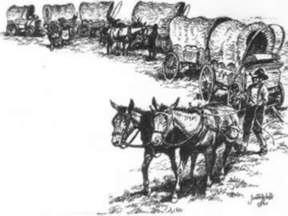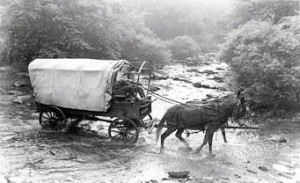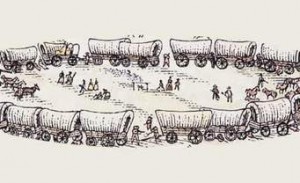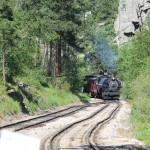supplies
 This summer when Bob and I were in the Black Hills, we were looking around in the gift shop at Mount Rushmore, when I came across a book called “Women’s Diaries Of The Westward Journey.” Since then, I have been thinking about what it must have been like to travel in a covered wagon…especially for a woman. Of course, times were different back then, and people did not have the luxury of a daily shower, or even a real bathroom…and that was in their own homes. So, imagine what life would be like on a wagon, traveling in a wagon train headed west in the mid-1800s. As the emigrants were traveling west, they were making their own roads, hunting their own food, and cooking over a campfire. For a lot of people, I’m sure this sounds like going camping, but then imagine doing it for months at a time. A day’s travel averaged about twelve to twenty miles, meaning that on the plains, they often stopped for the day within sight of the site they had just left that morning. For travelers now, that would seem insanely slow, but for the wagon trains, it was just the normal day’s journey. They knew no other way.
This summer when Bob and I were in the Black Hills, we were looking around in the gift shop at Mount Rushmore, when I came across a book called “Women’s Diaries Of The Westward Journey.” Since then, I have been thinking about what it must have been like to travel in a covered wagon…especially for a woman. Of course, times were different back then, and people did not have the luxury of a daily shower, or even a real bathroom…and that was in their own homes. So, imagine what life would be like on a wagon, traveling in a wagon train headed west in the mid-1800s. As the emigrants were traveling west, they were making their own roads, hunting their own food, and cooking over a campfire. For a lot of people, I’m sure this sounds like going camping, but then imagine doing it for months at a time. A day’s travel averaged about twelve to twenty miles, meaning that on the plains, they often stopped for the day within sight of the site they had just left that morning. For travelers now, that would seem insanely slow, but for the wagon trains, it was just the normal day’s journey. They knew no other way.
People back then would have been somewhat crazy to set out alone for the west…or to set out any later than spring, because either scenario was bound to fail. They needed the protection of the wagon train, as well as the  additional supplies, should a wagon be lost to fire, a river crossing, or an attack by Indians. It was their back up plan. They couldn’t just stop at the next town at a store and buy more supplies. There were no towns, stores, or even roads. When we travel, even in the rural state of Wyoming that I live in, we are used to seeing miles with very little to catch the eye, other that an occasional farm house, and an occasional town, but remember that we have roads to follow so we don’t lose our way. And even then, many of us use GPS to make sure we are taking the right road. They had none of that. They had to use the sun and landmarks to make sure they were going the right direction. They depended on people who had taken this trip before them. It was all they had. I think most of us today would go nuts if we never saw a house, a road, or a town. We would wonder if we were insane for setting out on this crazy adventure at all. One woman wrote to her husband, who was waiting at the end of the line, with the spelling ability she had at the time, “I can tell you nothing only that were hear and its strange I wish we had never started … it seems impossible to get their.” She had set out in a wagon train with her four children, without her husband, and that in itself must have been scary.
additional supplies, should a wagon be lost to fire, a river crossing, or an attack by Indians. It was their back up plan. They couldn’t just stop at the next town at a store and buy more supplies. There were no towns, stores, or even roads. When we travel, even in the rural state of Wyoming that I live in, we are used to seeing miles with very little to catch the eye, other that an occasional farm house, and an occasional town, but remember that we have roads to follow so we don’t lose our way. And even then, many of us use GPS to make sure we are taking the right road. They had none of that. They had to use the sun and landmarks to make sure they were going the right direction. They depended on people who had taken this trip before them. It was all they had. I think most of us today would go nuts if we never saw a house, a road, or a town. We would wonder if we were insane for setting out on this crazy adventure at all. One woman wrote to her husband, who was waiting at the end of the line, with the spelling ability she had at the time, “I can tell you nothing only that were hear and its strange I wish we had never started … it seems impossible to get their.” She had set out in a wagon train with her four children, without her husband, and that in itself must have been scary.
Days on the wagon train began long before dawn with a simple breakfast of coffee, bacon, and dry bread. After breakfast, the people secured their supplies, hitched up their teams, and hit the trail by seven o’clock in the morning. Most people walked because of lack of space, and the fact that the wagon was so uncomfortable. The  train stopped at noon for a cold meal of coffee, beans, and bacon, which had been prepared that morning. During this break, called nooning, men and women would gather and talk, children would play, and animals would rest. After that, the travel would continue until around six o’clock in the evening, when they wagons would circle for the night. Some people would visit after supper, but most went to bed, because they were exhausted. Some slept in the wagon, but most slept on the ground, because oddly enough it was more comfortable. While traveling west on the wagon trains was a necessary journey to be made to grow this country, it was not an easy journey to make, and for that reason, I have to stand in awe of those who did it.
train stopped at noon for a cold meal of coffee, beans, and bacon, which had been prepared that morning. During this break, called nooning, men and women would gather and talk, children would play, and animals would rest. After that, the travel would continue until around six o’clock in the evening, when they wagons would circle for the night. Some people would visit after supper, but most went to bed, because they were exhausted. Some slept in the wagon, but most slept on the ground, because oddly enough it was more comfortable. While traveling west on the wagon trains was a necessary journey to be made to grow this country, it was not an easy journey to make, and for that reason, I have to stand in awe of those who did it.
 Trains have always fascinated me. I love to ride them, and I love to watch them. I suppose that it could be something that is in my blood, since some of my family members, including my grandpa and my Uncle Bill both worked for the railroad. Or maybe it is just my personal opinion, but I think trains are cool. Whenever Bob and I go somewhere that offers a train ride, we try to plan that into our trip. If you have never taken a ride on a train, you really should consider it sometime. You won’t be disappointed. It is like a time machine, of sorts, taking you back into history.
Trains have always fascinated me. I love to ride them, and I love to watch them. I suppose that it could be something that is in my blood, since some of my family members, including my grandpa and my Uncle Bill both worked for the railroad. Or maybe it is just my personal opinion, but I think trains are cool. Whenever Bob and I go somewhere that offers a train ride, we try to plan that into our trip. If you have never taken a ride on a train, you really should consider it sometime. You won’t be disappointed. It is like a time machine, of sorts, taking you back into history.
The history of trains and the railroad itself is a fascinating one. In a very primitive form, trains existed back as far as 600BC, to move goods from ships to where they needed to go. Early miners had a primitive train since about 1500, called a Wagonway. It really was an invention of necessity. It was very difficult to haul ore out of a mine with a horse and wagon…or a wheelbarrow for that matter. By coming up with a way to transport the ore in wagons on a rail system, it got much easier. Of course, this system wasn’t much good if you were going to go very far, because let’s face it, a series of  wagons going very far is a slow mode of travel, and it wouldn’t be a Wagonway anyway, because that is called a Wagon Train…oddly enough.
wagons going very far is a slow mode of travel, and it wouldn’t be a Wagonway anyway, because that is called a Wagon Train…oddly enough.
The implementation of the rail system in the United States was necessary to our future too. Getting from one side of this country to the other is not an easy task. Even with the benefit of cars these days, driving cross country takes several days. And while the early trains weren’t much faster than our cars are, you could sleep at night, and keep going. At first the trains only carried supplies and such, but it wasn’t to be very long before they carried people. The first fare paying passenger train began operating in 1807 in Swansea, Wales. From that time on, more and more trains would carry passengers, and in many ways the world became a smaller place after that. Soon trains would criss-cross the United States, and train travel became common. It wasn’t common to just everyplace right away, however, but on this day, January 22, 1888, the first passenger train came into Cheyenne, Wyoming. It left the same day, making Wyoming history…two years before we even became a state.
 Travel by train would begin to make people feel like they had really come into the modern ages for a while, but with cars and airplanes, it wouldn’t take long for train travel to almost become obsolete. These days, I think that like me, most people ride the train systems because it is a novelty. Bob and I like to ride the 1880 Train from Keystone, South Dakota to Hill City, South Dakota. Basically it is like riding a train to nowhere, because while the two towns are real towns with stores, and people living there, for those riding the train, they are just a quick stop on the journey from one to the other and back again. The whole trip takes an hour one way, and with an hour layover in Hill City, we are back in Keystone in 3 hours…having done nothing more than to relax and enjoy the ride.
Travel by train would begin to make people feel like they had really come into the modern ages for a while, but with cars and airplanes, it wouldn’t take long for train travel to almost become obsolete. These days, I think that like me, most people ride the train systems because it is a novelty. Bob and I like to ride the 1880 Train from Keystone, South Dakota to Hill City, South Dakota. Basically it is like riding a train to nowhere, because while the two towns are real towns with stores, and people living there, for those riding the train, they are just a quick stop on the journey from one to the other and back again. The whole trip takes an hour one way, and with an hour layover in Hill City, we are back in Keystone in 3 hours…having done nothing more than to relax and enjoy the ride.
 In their early years, the railroads were quite powerful companies, and with good reason. The railroad reduced travel time across the United States from days or months, to hours, in many cases. They brought supplies, payroll, and people from back east to the west quickly. The railroad did not come without some confusion, however. Even as late as the 1880s, most United States towns had their own system for keeping track of time, based on where the sun was at high noon. I had never given much thought to this, but I suppose it could have been a big mess, since the train’s arrival would be very mixed up, and the end result would be that the train might be scheduled to arrive in several places at once.
In their early years, the railroads were quite powerful companies, and with good reason. The railroad reduced travel time across the United States from days or months, to hours, in many cases. They brought supplies, payroll, and people from back east to the west quickly. The railroad did not come without some confusion, however. Even as late as the 1880s, most United States towns had their own system for keeping track of time, based on where the sun was at high noon. I had never given much thought to this, but I suppose it could have been a big mess, since the train’s arrival would be very mixed up, and the end result would be that the train might be scheduled to arrive in several places at once.
Because the railroads were quite powerful, they took it upon themselves to make a monumental change that would affect the entire nation, and Canada too. At exactly noon on this day in 1883, American and Canadian railroads broke the continent into four sections, and began using a system of time zones that we still use to this day, with very few changes made to it over the years. I’m sure there were people who did not like the new system much, but most people quickly embraced it, because their lives depended on the railroad in one way or another. The root of the problem they had was that they moved passengers and freight over the thousands of miles the line covered. With the varying times in towns along the route, the train  ended up with dozens of different departure and arrival times. No one really knew when the train would arrive…except possibly the engineer. I’m sure that caused chaos in the train stations…especially in the bigger cities. These days, we have to be at the airport two hours early for flights, because of screening, so imagine that kind of a scenario in the small train stations of the old west. This scheduling nightmare had to be stopped, and time zones were the only logical way to do it.
ended up with dozens of different departure and arrival times. No one really knew when the train would arrive…except possibly the engineer. I’m sure that caused chaos in the train stations…especially in the bigger cities. These days, we have to be at the airport two hours early for flights, because of screening, so imagine that kind of a scenario in the small train stations of the old west. This scheduling nightmare had to be stopped, and time zones were the only logical way to do it.
With the use of time zones, rail transportation became far more efficient. The thing that seems rather odd, is that they didn’t go to the United States or Canadian governments to resolve the problem, and if the government at that time was as inefficient as our congress is right now, I can fully understand why they didn’t. Imaging waiting six years to make a decision concerning time and its vital role in rail travel. Something had to be done right away, and the railroad was just bold enough to do it. As it turned out, no one tried to stop them either. I suppose everyone could see just how logical their plan was, and no one complained. So, the railroad companies agreed to create four continental time zones, and that decision has changed the way we live to this day.
The lines they adopted to make those time zones were very close to the ones we have today. I’m sure that any changes are based on where towns began to fall along the zone lines. It wasn’t until as late as 1918 that Congress officially adopted the railroad time zones and put them under the Interstate Commerce Commission.  Just imagine, if you will, if the people and the railroad had waited for Congress to act on this matter. There would have been 35 more years of unorganized and frustrating railroad travel. Something that should have revolutionized travel, would have been relegated to the stone age again, because of Congress’ lack of action. Even after the system was implemented and people finally had an organized schedule, that was relatively accurate…because you can’t predict accidents or weather related delays very well, Congress sat on their hands, and I suppose they operated the government on government time instead. In this writer’s opinion, the time zones were a wonderful idea, and have benefitted this nation very well since 1883. My family has a long history of working on the railroad, and that is a fact that I am very proud of.
Just imagine, if you will, if the people and the railroad had waited for Congress to act on this matter. There would have been 35 more years of unorganized and frustrating railroad travel. Something that should have revolutionized travel, would have been relegated to the stone age again, because of Congress’ lack of action. Even after the system was implemented and people finally had an organized schedule, that was relatively accurate…because you can’t predict accidents or weather related delays very well, Congress sat on their hands, and I suppose they operated the government on government time instead. In this writer’s opinion, the time zones were a wonderful idea, and have benefitted this nation very well since 1883. My family has a long history of working on the railroad, and that is a fact that I am very proud of.

